The Windows RT Review
by Vivek Gowri & Anand Lal Shimpi on October 25, 2012 12:00 PM EST- Posted in
- Windows RT
- Operating Systems
- Microsoft
- Mobile
- Windows 8
- Tablets
User Interface, Gestures, and Multitasking
by Anand Shimpi and Vivek Gowri
By now you should be fairly familiar with what Windows RT’s Start Screen looks like, at least from a distance. Power on a Windows RT tablet and you’ll be greeted by the new Windows UI. A big, horizontal canvas full of live tiles, a feature that first debuted in Windows Phone 7. Based on the Metro design language, and referred to as Metro UI for much of the development cycle, a trademark dispute has forced a name change to Modern UI. There’s no getting around it, there’s a definite learning curve to the interface. It doesn’t matter if you’re used to Windows 7, OS X, Android or iOS, the touch enabled Windows RT UI is going to feel different, and probably downright wrong...at first.
If you put in the time to learn and get used to the interface however, it is easily among the best tablet user interfaces I’ve ever tried. Everything we despise Windows 8 for on the desktop makes perfect sense when viewed through tablet colored glasses.
As a recap, Windows RT (and Windows 8) relies on edge swipe gestures for much of the macro control over navigation. Full screen apps are left purposefully barren, with their focus primarily on content. The power is in what lies (virtually) beyond the edges of the screen.
There’s no capacitive sensor array in the bezel of a Windows RT tablet, instead what the touch controller does is looks at starting position and velocity of gesture to determine whether your swipe originated on or off screen.
There are only four edge swipes you need to learn, one for each edge of the display. Swipe in from the left and you flip through apps, giving Microsoft the win for quickest task switcher among all tablets. By default a left edge swipe will switch to the previously used app, or if you just switched from that it’ll move to the next most-recently used app.
If you have a lot of apps to switch between simply left edge swipe in partially then swipe back out, revealing a more traditional task switcher (Windows + Tab also brings up this switcher). Of all of the Windows RT gestures the swipe in/out to bring up the task switcher is the most clunky, but it’s easy to get used to.
Go to the opposite side of the screen and right edge swipe in to reveal the charms bar. Here you get direct access to the software start button as well as a bunch of key tools, among them are search and settings.
Although the appearance of the charms bar never changes, the function of these buttons do. Start always takes you to the start screen, but search and settings apply to the app currently in focus. I can’t stress how much of an advantage this is over iOS. If I need to play with an app setting on the iPad I either need to go home and to settings then find the app or hope the developer has stuck a tab somewhere in the app where I can play with options.
Even better is the fact that I can toggle things like an app’s ability to run in the background and whether or not it’s allowed to give me notifications on the lock screen directly from the app settings page. The icing on the cake? Playing with settings never forces me out of the app itself, Windows RT simply devotes the right 1/4 of the screen to settings, leaving my app still in focus on the left. It’s perfect.
Also perfect? The ability to snap applications to the right or left edge of the screen and have a different window open in the remaining portion. This was called Metro Snap before use of the Metro name was discontinued, and it’s one of the more interesting features here. Snapping requires a screen with at least 1366 horizontal pixels, allocated as 1024 to the main window, 22 to the splitter, and 320 to the snapped application panel. It’s great for having an IM conversation or email inbox open on the side when writing, browsing, or doing essentially anything else.
One of the biggest issues I’ve had with tablet multitasking to date is that it’s all been very focused on the active window, which makes doing things like messaging an absolute pain because you’re continually flipping between whatever you were doing (let’s say browsing the web) and the messaging application. In Windows RT though, you just snap the conversation window to the side and continue browsing, just with a narrower browser window.
Messaging is just one usecase though - email, Facebook, Twitter, Skype video calls (their implementation is pretty cool - more on this later), music, a small browser window docked on the edge while writing in the main screen, the possibilities are endless. You could even theoretically turn it into three near-equal size windows using Aero Snap in Windows desktop, though that severely cuts down on usable space. But generally, the Snap feature gives the end user a lot of flexibility and makes multitasking a lot easier.
Top and bottom edge swipes end up being more application specific. Swipe up from the bottom and you usually get some additional options, while swiping down from the top edge is usually more of a navigational tool (e.g. showing multiple tabs in IE10).
Although Windows RT borrows from its iOS and Android brethren in that it will automatically pause and unload unused apps from memory, you can always manually move the process along by edge swiping down from the top and dragging the window off the bottom of the screen. This also works from the task switcher on the left side, drag over and down to the bottom of the screen to close. There’s some built in lag to ensure that you don’t accidentally quit something of importance but otherwise it works fine.
Overall, the edge swipe gestures take some getting used to but once you’ve made it over the hump they really unlock a totally new level of tablet usage.
I believe Microsoft is on to something real here with the new Windows UI for tablets. This new OS feels ahead of the curve on major issues like multitasking, task switching and displaying multiple apps on the screen at the same time. I was always told that marketshare is lost and gained in periods of transition. Microsoft missed the first major transition to new ARM based smartphones and tablets, but it’s perfectly positioned to ride the wave to notebook/tablet convergence. In fact, when it comes to figuring out how to merge those two platforms I don’t believe Apple or Google have a reasonable solution at this point. In Apple’s world the two are distinctly separate, while Google is arguably even worse off as it doesn’t have a good notebook OS at this point (the verdict is still out on Chrome OS, as promising as the new Samsung Chromebook appears to be). It’s unclear how big this convertible/hybrid market will grow, but I see real potential here. There are users who want an iPad and I don’t believe Microsoft does anything to change their minds. The iPad and iOS remain a very polished, very accessible platform that is really optimized for content consumption and light productivity. For anyone who wanted more however, there’s now an alternative: Windows RT.


_575px.png)
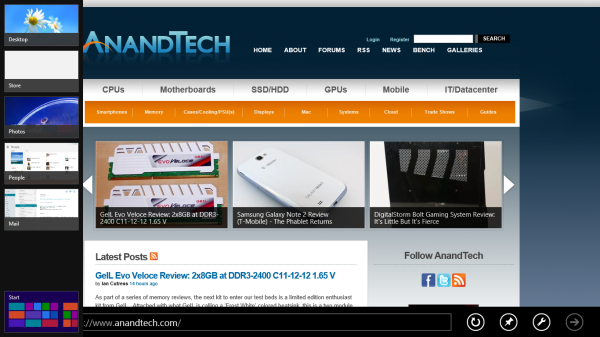
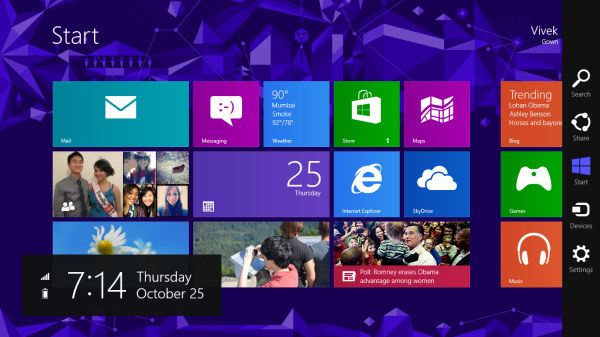
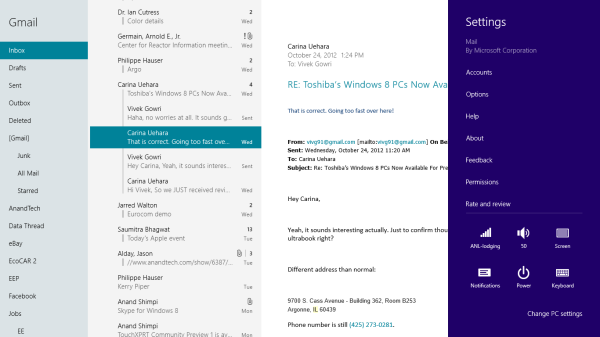
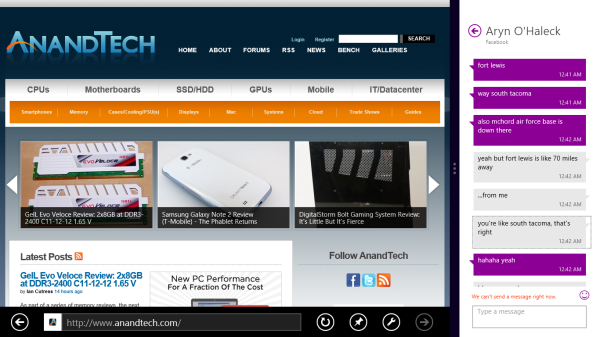

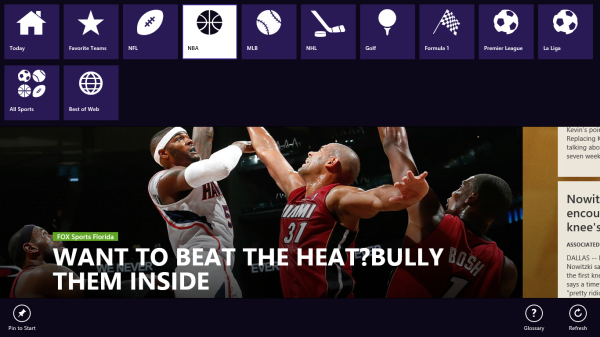








233 Comments
View All Comments
Dorek - Friday, November 2, 2012 - link
AFAIK, task manager tray doesn't even have thumbnails. Come on, it's not comparable to what Windows 8 and Windows RT do. Have you used them?yyrkoon - Sunday, October 28, 2012 - link
The software issue, will not be much of an issue at all.Microsoft will just write another abstraction layer ( HAL ) for ARM. Which is most likely what they've done here.
Passed that. IF any abstraction layers need to be written for the COM model, or .NET libraries. You can rest assured Microsoft will cover that as well. If it hasnt been covered already. Which Im betting it has.
Again, this is nothing like WinCE.This is a real OS, for real end users, with a different HAL.
The biggest issue as I've stated in previous posts. Is not whether it will be easy to write applications for Windows RT. But whether software developers deem it prudent to spend thousands of dollars on Microsoft development tools( not absolutely necessary ). THEN pay Microsoft a forced 30% distribution fee. Through their app store.
For me personally. The 30% fee alone is enough for me to jump ship. And I really enjoy writing apps for Windows. We'll see how it all works out in the end.
karocage - Friday, October 26, 2012 - link
This comment from the article seemed odd to me:"This isn’t like Windows Phone, where we need to see whether the platform will get any market traction before predicting the growth of the app marketplace."
Market traction and app store growth don't seem to have much if any relationship with Windows Phone. WP7 hit 100,000 apps faster than either iOS or Android and has over 125,000 now. If anything, that would seem to indicate that MS really does have a lot of pull with developers independently of market share. So while I agree that the sheer number of devices will be a big draw, I'd argue that's just the cherry on top that guarantees we're going to see a ton of support really quickly for RT/Metro apps.
Obviously buying a WinRT tablet today will be pretty limiting in terms of 3rd party software, but experience from WP7 suggests this will be a very short-lived downside of the platform.
Dorek - Friday, November 2, 2012 - link
Good point. I've been on Windows Phone 7.5 for a year, and have never had the problem of not being able to find an app I want. (With the exception of Pandora, the assholes. Can't even use third-party ones because they block them. But I have a Zune--I mean, Xbox Music Pass anyway. So screw Pandora.)andypost - Friday, October 26, 2012 - link
Anandtech writes the best articles. period.Thanks to Vivek Gowri and Anand Lal Shimpi for a great article.
Visual - Friday, October 26, 2012 - link
You say it is impossible to make desktop apps, but...I read that Win RT still has PowerShell. A lot of PowerShell scripts on x86 just invoke various functions in third-party ActiveX controls, which are just x86 executable binary libraries, and that will not work on RT... but maybe at least the core MS objects still work? For example, if Windows Forms or Windows Presentation Foundation still works, then PowerShell scripts can create desktop windows with various GUI elements.
And since there is an IE, maybe HTA applications work as well?
Do you have some scripting geek working at AT that could test these theories out?
On another topic, I am very surprised you say there are x86 executables on your install. That is just wasted space on a device that doesn't get a large drive to begin with anyway. MS would get in serious trouble if it were true... Are you sure?
And lastly, I am curious if a Win RT device is supposed to be able to get plugged to a "real" Windows computer over USB for charging or for as a mass storage drive, for transfering files... If it is, then coudn't you also plug one RT device to another RT device? Then which one will become the "host", and which one will become the peripheral?
Dorek - Friday, November 2, 2012 - link
"And lastly, I am curious if a Win RT device is supposed to be able to get plugged to a "real" Windows computer over USB for charging or for as a mass storage drive, for transfering files... If it is, then coudn't you also plug one RT device to another RT device? Then which one will become the "host", and which one will become the peripheral?"Dude...that's deep.
(That's actually a really good question. Surface can't be charged over USB, but I don't know about other ARM devices.)
tommo123 - Friday, October 26, 2012 - link
i mean if someone writes an app and gives it away. there's no sideloading so if has to go through the store right?will microsoft host it for free? if not then they're effectively killing off free software for windows are they not? at least win rt which is eventually (how they'd like) desktop windows to go too.
tipoo - Friday, October 26, 2012 - link
Yes they'll host it for free. And there are many free apps already, there was a influx of apps on launch day and most reviews were done before that. They only take a percentage of the cuts from paid apps, nothing from free.Visual - Friday, October 26, 2012 - link
I forgot one question in my previous post.How is the browser performance with many many tabs open at once? Like 20, or even 100?
I sometimes use tabs in a bit weird way, ctrl+clicking possibly interesting links in some large index page to open them in a background tab for later reviewing it in more detail. Even without Flash, with IE9 starting a new process for each tab by default and a few animated gif ads and various JS scripts on each tab, it really kills Atom Netbooks and even CULV Core 2. It's probably more of a memory usage thing than a CPU thing actually... But anyway, how could that go on these new ARM devices?